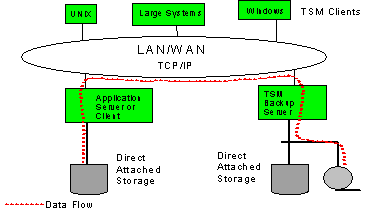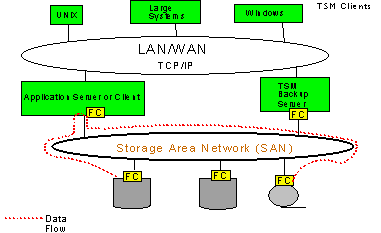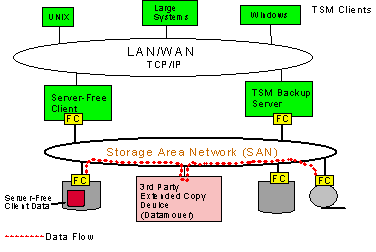Abstract
This tip will define and help you to understand the terms: LAN/WAN backup; server-free backup; LAN-free backup; and split-mirror backup.
Contents
LAN/WAN backup
In a traditional LAN and WAN environment the Tivoli Storage Manager backup and archive client or application would read data from locally attached disks and then send it over the LAN to the Tivoli Storage Manager backup server as shown in the picture below. The server receives the data then writes it out to its storage pool - tape, disk, or optical media - based on predefined policies and server configuration. Data is read and written by both the Tivoli Storage Manager client and Tivoli Storage Manager server machines. In addition, control information is also sent over the LAN to the Tivoli Storage Manager server.

SAN (LAN-free) backup topology
SAN technology provides an alternative path for data movement between the TSM client and the server. Shared storage resources (disk, tape) are accessible to both the client and the server through the Storage Area Network. Data movement is off-loaded from the LAN and from the server processor and allows for greater scalability. LAN-free backups decrease the load on the LAN by introducing a Storage Agent. The Storage Agent can be thought of as a small TSM server (without a Database or Recovery Log) which is installed and run on the TSM client machine.
The Storage Agent handles the communication with the TSM server over the LAN but sends the data directly to SAN attached tape devices, relieving the TSM server from the actual I/O transfer. A LAN-Free backup environment is shown below.

Server-free backup
Server-free backup/restore capability is introduced into IBM Tivoli Storage Manager (TSM) in Version 5. In a server-free backup environment data is copied directly from the SAN attached Tivoli Storage Manager client disk to the SAN attached tape drive via the SAN Data Gateway data mover as shown below. The Storage Agent used in LAN-free backups is not used. The data movement is actually done by a SAN Data Gateway (SDG) or similar device on the SAN. Therefore, both TSM client and server machines do not have to read and write the data at all. The TSM server sends commands to the SDG device to tell it which blocks to move from which SAN attached disk to which SAN attached tape device. The data is actually copied rather then moved from one location to another. This provides a way to back up and restore large volumes of data between client-owned disks and storage devices using a method that considerably reduces overhead on the TSM server and the client.
Only volume images and not individual files can be moved by Server-free Data Movement. The data is transferred block by block rather than by doing file I/O. Both Raw and NTFS volumes can be backed up using Server-free Data Movement. Data that has been backed up using Server-Free Data Movement can be restored over a server-free path, over a LAN-free path, or over the LAN itself. The impact on application servers is now minimized with Server-Free Data Movement. It reduces both TSM client and server CPU utilization.
The use of a SCSI-3 extended copy command causes data to be transferred directly between devices over the SAN or SCSI bus. The data mover device must support the SCSI-3 EXTENDED COPY command, which conforms to the ANSI T10 SPC-2 standard. The data mover device can be anywhere in the SAN, but it has to be able to address the LUNs for both the disk and tape devices it is moving data between.

Split-mirror/point-in-time copy backup using SAN
A split-mirror/point-in-time backup occurs when a copy volume generated by operating system mirroring or a hardware assisted instant copy function (as found on many of today’s storage systems) is backed up to a TSM server, as shown below. Such a backup method virtually eliminates the backup-related performance impact on the production host. This approach is facilitated and automated with the IBM Tivoli Storage Manager for Hardware component by integrating IBM's Enterprise Storage Server FlashCopy function with IBM Tivoli Storage Manager and its database protection capabilities for Oracle, R/3, and DB2. Likewise, EMC's Symmetrix TimeFinder integrates with IBM Tivoli Storage Manager and its protection capabilities for Oracle and R/3. This copy-backup procedure adds value to your storage and backup procedures because it helps ensure that essential applications can continue to run 24 x 7 with minimal backup-related impact.





